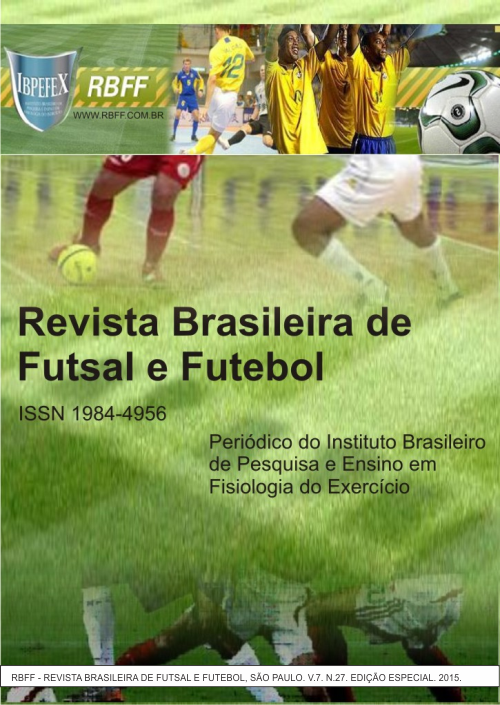Analysis of vertical jump in the elementary school athletes of the sub-15 to sub-17 feminine from Rio Grande da Serra, São Paulo
Abstract
The vertical jump has been highlighted in the literature as a primary method of measurement of power of lower limbs for athletes and physically active subjects. In fact, this is integral to motor action sports such as volleyball, handball, football, basketball and athletics certain part. The aim was to evaluate and compare two vertical jumps, known as JUMP TEST SARGENT. 12 female athletes football and futsal , Escola Estadual Padre Giuseppe Pisoni from Rio Grande da Serra, Sao Paulo were evaluated in the training phase. The athletes have an average age between 14 and 17 years. After familiarization test, the vertical jump was assessed. The study results had a difference between the heels and the average score for the first jump was 0.24cm and the second jump was 0.34cm of football and futsal. Moreover, for women's categories, there are not many data in the literature for future reference. These parameters are important in practice, so that the coach can track the performance of athletes undergoing evaluation. In conclusion, there was a small increase vertical jump with the data obtained in the two tests, and in practice a significant performance improvement.
References
-Altimari, L. R.; Dias, R. M. R.; Goulart, L. F.; Avelar, A.; Altimari, J. M.; Moraes, A. C. Comparação dos efeitos de quatro semanas de treinamento com pesos e circuito específico sobre o desempenho em corridas intermitentes e da força de jovens futebolistas. Brazilian Journal of Biomotricity. Vol. 2. p. 132-142. 2008.
-Barbanti, V. J. Manifestações da força motora no esporte de rendimento. Esporte e Atividade Física. Manole. 2002. p. 19.
-Balson, P. Evolution of physical performance.In Ekblom, B. Football (soccer). Londres. Bachwell Scientific Publication. Vol. 151. Suplementein 619. 1994.
-Brown, L.E.;Weir, J.P. (ASEP) Procedures Recommendation I: Accurate Assessment of Muscular Strength And Power. J Exe Phy. Vol. 4. p. 1-21. 2001.
-Coffey, V. G.; Hawley, J. A. The molecular bases of training adaptation. Sports Medicine. Vol. 37. p. 737-763. 2007.
-Cronin, J.B.;Hing, R.D.; Mcnair, P.J. Reliability and validity of a linear position transducer for measuring jump performance. J Strength Cond Res. Vol. 18. p. 590-593. 2004.
-Cronin,J.B.;Hansen,K.T. Strength and power predictors of sports speed. J Strength Cond Res. Vol. 19. p. 349-357. 2005.
-Chelly, M. S.; Fathloun, M.; Cherif, N.; Ben Amar, M.; Tabka, Z.; VanPraagh, E. Effects of a back squat training program on leg power, jump, and sprint performances in junior soccer players. Journal of Strength and Conditioning Research. Vol. 23. p. 2241-2249. 2009.
-Christou, M.; Smilios, I.; Sotiropoulos, K.; Volaklis, K.; Pilianidis, T.; Tokmakidis, S. P. Effects of resistance training on the physical capacities of adolescent soccer players. Journal of Strength and Conditioning Research. Vol. 20. p. 783-791. 2006.
-Laffaye, G.; e colaboradores. Principal component structure and sportspecific differences in the running one-leg vertical jump. International Journal of Sports Medicine. New York. Vol. 28. Núm. 5. p. 420-425. 2007.
-Gonçalves, H.R.; Arruda, M.; Valoto, T.A.; Alves, A.C.; Silva, F.A.; Fernandes, F. Análise de informações associadas a testes de potência anaeróbia em atletas jovens de diferentes modalidades esportivas. Arq. Ciênc. Saúde Unipar. Umuarama. Vol. 11. Núm. 2. p. 115-121. 2007.
-Ham, D.J.;Knez, W.L.;Young, W.B. A deterministic model of the vertical jump: implications for training. J Strength Cond Res Vol. 21. p. 967-972. 2007.
-Ham, D.J.; Knez, W.L.;Young, W.B. A deterministic model of the vertical jump: implications for training. J Strength Cond Res. Vol. 21. p. 967-972. 2007.
-Impellizzeri, F.M.; Rampinini, E.; Castagna, C.; Martino, F.; Fiorini, S.; Wisloff, U. Effect of plyometric training on sand versus grass on muscle soreness and jumping and sprinting ability in soccer players. British Journal of Sports Medicine. Vol. 42. p. 42-46. 2008.
-Komi,P.V.;Bosco,C. Utilization of stored elastic energy in leg extensor muscles by men. Med Sci Sport Exerc. Vol. 10. p. 261-265. 1978.
-Maughan, R.; Gleeson, M.; Greenhaff, P. L. Bioquímica do exercício e treinamento. Manole. 2000.
-Moir,G.; e colaboradores. Influence of familiarization on the reliability of vertical jump and acceleration sprinting performance in physically active men. Journal of trength and Conditioning Research. Colorado Springs. Vol. 18. Núm. 2. p. 276-280. 2004.
-Prue, P.; Mcguigan, M. R.; Newton, R. U. Influence of Strength on the Magnitude & Mechanisms of Adaptation to Power Training. Medicine andScience in Sports and Exercise. 2010.
-Sayers, S.; e colaboradores.Cross-validation of three jump power equations. Med Sci Sports Exerc. Vol. 31. p. 572. 1999.
-Ugrinowitsh, C.; Tricoli, V.; Rodacki, A.L.F.; Batista, M.; Ricard, M.D. Influence of training background on jumping height. J Strength Cond Res. Vol. 21. p. 848-852. 2007.
-Young, W. B. Transfer of strength and power training to sports performance.International Journal of Sports Physiology and Performance, Vol. 1. p. 74-83. 2006.
Authors who publish in this journal agree to the following terms:
- Authors retain the copyright and grant the journal the right of first publication, with work simultaneously licensed under the Creative Commons Attribution License BY-NC which allows the sharing of the work with acknowledgment of the authorship of the work and initial publication in this journal.
- Authors are authorized to enter into additional contracts separately for non-exclusive distribution of the version of the work published in this journal (eg, publishing in institutional repository or book chapter), with acknowledgment of authorship and initial publication in this journal.
- Authors are allowed and encouraged to post and distribute their work online (eg, in institutional repositories or on their personal page) at any point before or during the editorial process, as this can bring about productive change as well as increase impact and impact. citation of published work (See The Effect of Free Access).





